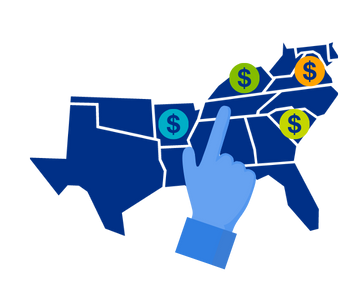Updated dashboard shows latest teacher compensation trends in SREB states
New data shows teacher pay in the South still lags national average
A new interactive tool that helps policymakers explore pay and benefits in the 16 states represented by the Southern Regional Education Board is now live at SREB.org/TeacherCompensationDashboard.
SREB has updated its comprehensive Teacher Compensation Dashboard with the region’s latest available data on salaries, health insurance, retirement, benefits and more. The 2023 tool has a new interface that allows users to:
- See a profile of a state’s compensation package for its teachers
- Compare one state to another, the South, or the rest of the nation
- Browse detailed information and trends for up to seven years
SREB President Stephen L. Pruitt says the revised dashboard aims to make it easier for state leaders to analyze all aspects of teacher compensation.
“The teaching workforce needs our attention,” Pruitt said. “The quality of our children’s education is an economic driver, and how we compensate educators is an important part of attracting good teachers and retaining them as they get even better.”
Top takeaways and considerations for policymakers from the latest data
Salaries
The South lags the nation overall in average teacher salaries by almost 15%, despite a lower cost-of-living index. The average salary for teachers in the SREB region was $55,676 in 2021. Even when adjusted for inflation, that’s lower than in the 1980s.
Policy consideration: Look at average salaries for beginning teachers versus later-career teachers in your state. Consider how these might affect recruiting new teachers and retaining experienced ones.
Health Benefits
Health costs continue to rise steadily. On average,
employee-only premiums are lower for teachers than for other
professionals. Family coverage in many states, though, is more
expensive for teachers than in the private sector.
Policy consideration: Keep an eye on family premiums and explore
options to make or keep them affordable.
Retirement Benefits
All SREB states offer defined benefit (pension) plans. Nearly all states have lower pension benefit formulas for newly hired teachers, which reduces the gross benefit-earning capability of newer teachers.
Policy consideration: Six states have portable investment or hybrid plan options, which can allow younger teachers to save more and be a cost-saving measure for states.
Take-Home Pay
SREB calculates what the average teacher in each state brings home in their paycheck after deducting retirement, health insurance and taxes. The average annual net pay for the 16-state SREB region is up slightly from last year: $29,420 for first-year teachers, $36,663 for teachers in their 15th year, and $46,296 for teachers in their 35th year of teaching.
Policy consideration: Understand the total compensation package for teachers in your state when you are making decisions about benefits and salaries.
“Elevating the teaching profession is how we solve shortages and improve education,” said Megan Boren, who leads SREB’s teacher workforce policy efforts. “That begins with how we prepare teachers and support their professional development, but compensation is also an important element in attracting and keeping teachers, especially when it connects to licensure levels.”
For interviews and more information on teacher workforce data in your state, please contact SREB Communications.



 The newly revised Educator Compensation Dashboard features state-by-state annual data for the South on average compensation packages to teachers and leaders, including salaries, retirement benefits, health benefit options and calculations on typical take-home pay for teachers. The dashboard now also contains salary information for early childcare workers.
The newly revised Educator Compensation Dashboard features state-by-state annual data for the South on average compensation packages to teachers and leaders, including salaries, retirement benefits, health benefit options and calculations on typical take-home pay for teachers. The dashboard now also contains salary information for early childcare workers.